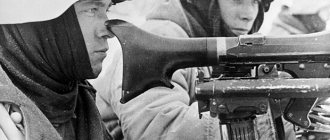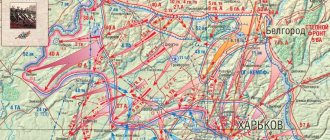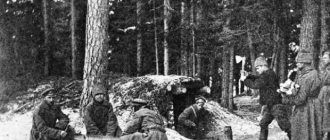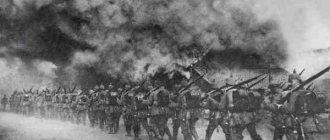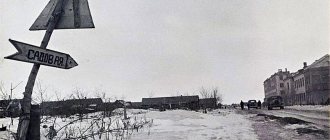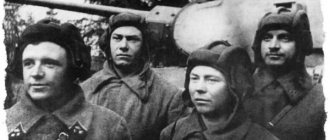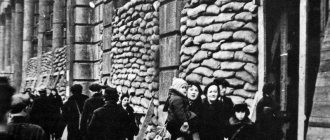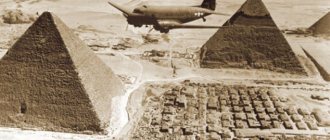At the end of 1942, the situation near Leningrad was difficult: there was no land connection between the city and the “Mainland”, the troops of the Leningrad Front, as well as the Baltic Fleet, were isolated. During the forty-second year, our Armed Forces twice attempted to break the blockade. However, the Lyuban and Sinyavinsk operations were not successful. As before, units of the German 18th Army occupied the area between the southern coast of Ladoga and the village of Mga (here the distance between the Leningrad and Volkhov fronts was the shortest - only 12-16 kilometers).
In connection with these circumstances, the Headquarters of the Supreme High Command decided to develop a plan for a new operation, which was called “Iskra”. The troops of the Leningrad and Volkhov fronts were supposed to defeat the enemy group in the area of Lipka, Gaitolovo, Moskovskaya Dubrovka, Shlisselburg and thus break the siege of the city on the Neva, reaching the line Moika River - Mikhailovsky - Tortolovo. The operation was planned to be completed at the end of January forty-three. The operation took almost a month to prepare. The preparation was comprehensive. The command and staffs of the two fronts coordinated their plans, established demarcation lines and worked out interactions.
Why did it take so long for them to break through the blockade ring?
In quantitative terms, near Leningrad, the superiority was on the side of the USSR, but it was completely offset by the better equipment of the enemy - they had more machine guns, machine guns and mortars, and they had powerful artillery support. In addition, in many places their location gave them unconditional superiority in battle, for example, higher points from which there was excellent visibility of the areas under fire. And the Soviet soldiers were exhausted by continuous battles with the invaders, writes spbvedomosti.
Strengths and characteristics of the parties' organization
For the sake of the success of the most important operation, the USSR took all possible measures to strengthen the shock units of the Leningrad and Volkhov fronts, which were supposed to simultaneously attack the Shlisselburg ledge from two sides. The sending of numerous reserves made it possible to ensure a 5-fold superiority over the enemy in terms of the number of troops. In total, about 300 thousand people were supposed to participate in the offensive, supported by almost 5 thousand guns, more than 600 tanks, 809 aircraft.
The Nazis at the attack site had approximately 60 thousand ground soldiers, 250 aircraft, 700 guns. Their main strength was the deep echeloning of defense. There was one more nuance that was poorly taken into account by the Soviet side: German tank crews near Leningrad had several of the latest heavy Tiger tanks at their disposal. Soviet soldiers were unfamiliar with them, did not know the vulnerabilities of their design and could not effectively fight them (they had to shoot at random). These vehicles were studied by Soviet specialists already during the battles (and only then did recommendations for countering them appear).
Knowing the strength of the enemy’s defense in the breakthrough area, the Soviet command paid great attention to the training of fighters. Training camps were built where soldiers were taught to overcome layered defenses. Overall command of the preparation and implementation of the operation was carried out by Lieutenant General L.A. Govorov (Leningrad Front), Army General K.A. Meretskov (Volkhov Front), as well as G.K. Zhukov and K.E. Voroshilov as coordinators from Headquarters.
Operation Spark
Initially, Operation Iskra was scheduled for January 1; it was postponed to January 12 only because the Neva had not yet frozen. The Russian command, using trial and error, spent a long time looking for a breakthrough point and decided to operate in the narrowest point of the German defense - the “bottleneck” at Ladoga. Only 14 km separated the blockade ring there from the mainland. The general plan of the operation was to defeat the group of fascist troops with counter strikes from two fronts - Leningrad from the west and Volkhov from the east.
Researcher Vyacheslav Mosunov says:
“Breaking the blockade cost us almost 70 thousand killed, wounded and missing soldiers and commanders.”
You can't bomb ice
Also, not everything went smoothly during the offensive: sometimes the length of the assault ladders was not enough to reach the height of the shore, and the soldiers had to quickly change the location of the climb.
It was also hard for the two penal companies (158th and 159th) advancing in the area of the state district power station. The penalty soldiers suffered serious losses, coming under machine-gun fire from the bowels of the concrete giant. Nowadays, some historians are sure: the crossing of the Neva in this section was a diversionary maneuver.
GRES-8 (now Dubrovskaya CHPP-8) rises above the Neva.
The infantry was supported by light T-60, BT-5, T-26 and armored vehicles. Armor-piercing shells pierced them right through. As the interlocutor emphasizes, the first day from the Lenfront offensive passed without heavy tanks - it was necessary to build crossings for them: such ice would definitely not have withstood them. However, later the overall superiority in heavy equipment was achieved by more than 10 times.
Red Army soldiers and BT tanks on the ice of the Neva.
The offensive was covered by mounted machine-gun fire, which did not allow the Nazis to raise their heads from the fortifications. The artillery covered the enemy positions to a depth of 200 meters, while from the shore the cannons hit the front line, mixing the fortifications into mush.
Soviet artillerymen fire from an M-30 howitzer. Leningrad Front.
“Everything was calculated so as not to break the ice and preserve the crossing for equipment, the supply of ammunition, and the approach of replenishment. According to some reports, the density of fire on the enemy shore during the breakthrough was three shells with a caliber of at least 76 mm per 1 square meter,” the interlocutor notes.
Thus, the fighters in the direction of the main attack in Maryino passed the first line of fortifications relatively easily. However, there remained a wooded area ahead, where individual enemy defense points were hidden.
The infantry and tanks of the 152nd Tank Brigade of Colonel P. I. Pinchuk are preparing for the offensive. Leningrad Front.
Victory Road, or Death Corridor
Six days of intense fighting allowed for a breakthrough, but Leningrad was still in a state of siege. But the Red Army soldiers did the most important thing - they ensured the construction of the railway, reports tsargrad.tv. On the same day, they began to build it south of Lake Ladoga.
Railway
Photo: press service of the Department of Transport of the Ministry of Internal Affairs for the Siberian Federal District
In just 19 days, a line with a length of 33 km was laid - the Victory Road, or the Corridor of Death; in some sections the rails were too close to the fascist positions, sometimes literally three kilometers away. The enemy easily carried out artillery attacks on the trains. Soviet troops conquered every meter of the Victory Road, but in Leningrad they were able to increase the supply of electricity, water appeared in the city, and bread distribution standards were increased.
Train traffic was regulated by women accompanied by machine gunners. Day and night they sat along the corridor with kerosene lanterns - green and red. As soon as they learned about the next breakthrough of our troops, they immediately turned on the corresponding lamp, and the train with provisions could move on.
In a deadly ring
The blockade ring closed around Leningrad on September 8, 1941, in the darkest and most hopeless days of the war. The Red Army was retreating. Together with residents of suburban areas, almost 3 million civilians found themselves in the grip of encirclement. The Germans failed to capture the cradle of the revolution. Following their inhuman logic, they decided to destroy the city by starvation and bombing. They left no chance for life for Leningraders.
blockade
Residents of besieged Leningrad collect water from holes in the asphalt after artillery shelling
Photo: RIA Novosti/Boris Kudoyarov
Feat and pain: the heroic 872 days of the siege of Leningrad
The city survived against all odds
In the diary of General Franz Halder, who headed the General Staff of the Wehrmacht, the following entry appeared in those days: “The Fuhrer’s decision to raze Moscow and Leningrad to the ground is unshakable in order to completely get rid of the population of these cities, which otherwise we will feed during the winter. The task of destroying cities must be carried out by aviation. Tanks should not be used for this.” “The Fuhrer would like to raze Leningrad to the ground and then hand it over to the Finns,” wrote Hitler’s close ally Martin Bormann.
The most difficult time was the beginning of the first winter of the siege. On November 20, Leningraders began to receive 250 g of bread on a work card and 125 g on an employee and children's card. Only a third of the residents were entitled to work cards. The city was starving. It was possible to increase the standard only on December 25. Workers were given 100 g of bread, employees, dependents and children - 75 g each. Life sometimes depended on the extra 5 g... Flour had to be replaced with hydrocellulose - that is, essentially processed wood.
blockade
125 g of bread on a scale, the established norm for employees, dependents and children during the siege of the city during the Great Patriotic War, Leningrad, 1941
Photo: TASS/Nikolai Adamovich
“Thanks to those who survived, we were born”
Public opinion leaders talk about the significance of the Day of Lifting the Siege of Leningrad for each Russian
The winter turned out to be exceptionally cold - frosts reached −32 degrees. There was no electricity, the water supply was frozen, and the sewage system did not work. The last thread connecting the city with the country was the Ladoga Ice Road of Life. At the Nuremberg trials, it was established that 649 thousand civilians became victims of the blockade; modern historians believe that in reality this figure was at least 800 thousand. Most of them were killed by hunger.
Even at the end of 1942, Hitler was confident that the Red Army would not be able to break through the blockade ring - and the city would sooner or later die out. But the Soviet command had a different opinion on this matter.
From the diaries of siege survivors
Varvara Frolova, head physician of the nursery and tuberculosis dispensary:
“Hurray, hurray, hurray! Yesterday at the “Last Hour” they announced the breaking of the blockade of Leningrad. The wonderful day of January 18, 1943 will be a holiday for all Leningraders for the rest of their lives. The radio played music and greetings throughout the night. Today everyone is happy and cheerful. Is this the beginning of the end? I wish I could!”
Nikolay Gorshkov, senior accountant at the Leningrad Institute of Light Industry:
“There is jubilation everywhere. People kiss, there are tears of joy in their eyes. Victory, victory. The radio doesn't stop all night. No one could sleep that night. Leningraders waited for the desired day. Joy and happiness. Death to the German occupiers."
February 28, 12:09
Offensive "in a bag of fire"
...Since those times, it seems, nothing has changed: the open area, the gray sky falling on the stunted birch trees, the disgusting stench from the unfrozen reclamation canal.
You step onto a white field, as smooth as a table. There is frozen snow on top, the crust crunches. And suddenly you go knee-deep, and below there is unfrozen peat slurry, greedily dragging you to the bottom. It’s easy for a person to fall through and drown here, and for cars and tanks it’s completely fatal.
“Since the early 1920s, peat has been extracted here using the hydraulic method. Therefore, there are only two types of landscape: bare fields and ditches and holes filled with water. Moreover, three Sinyavinsky offensive attacks have already rolled through this swamp - all of them are pitted with craters. One hope is the sandy embankments of narrow-gauge railways laid before the war, along which peat was exported: it was only possible to move normally along them, explains the senior researcher. — The conditions for the offensive are disgusting. But this was the only place where the German could not get a hold.” Enemy fortifications were hidden in all “strong” places.
Sappers of the 611th separate sapper battalion of the 327th rifle division of the Volkhov Front make passages in a wire fence in the Sinyavin area.
For example, the stronghold of the Round Grove was very large. One of its parts saddled the only normal road - the Putilovsky tract, and even until October 1943 remained with the Germans. However, they managed to go around the object and move forward.
Soviet heavy tank KV-1. Volkhov Front.
“It was a hard attack. The division could lose more than 3 thousand people killed and wounded per day,” the senior researcher emphasizes. – For example, Workers’ settlements No. 5 and No. 8 are located on hills, with about 6 km between them. The area is clearly visible from the Sinyavinsky Heights. They also beat from the Ladoga dune - the hill where the Murmansk highway is now laid - then there were barracks there. The military calls this a “bucket attack.”
German defense in the area of the Shlisselburg-Sinyavinsky ledge
The defense of the Shlisselburg-Sinyavinsky ledge was carried out by the main forces of the 26th Army and part of the divisions of the 54th Army Corps of the 18th Army.
Due to the significant superiority of the Soviet army in manpower and equipment, the German command hoped to hold its position primarily due to the power of its defense: most of the villages were strongholds, the front line and positions in the depths of the defense were fenced with minefields, barbed wire barriers and fortified with bunkers.
In the offensive zone of the 67th Army, the defense was held by the 328th Regiment of the 227th Infantry Division, the 170th Infantry Division in full force and the 100th Regiment of the 5th Mountain Division[14]. On the first line, the main defense units were the buildings of the 8th State District Power Plant, the 1st and 2nd Gorodki and the houses of the city of Shlisselburg. The second line of defense passed through workers' settlements No. 1 and No. 5, Podgornaya and Sinyavino stations, workers' settlement No. 6, and the Mikhailovsky village.
In the offensive zone of the 2nd Shock Army and the right wing of the 8th Army, the defense was held by the 227th Infantry Division (minus one regiment), the 1st Infantry Division, the 374th Regiment of the 207th Security Division and the 344th Regiment of the 223rd th infantry divisions. The main centers of resistance were Lipka, Rabochy settlement No. 8, the Kruglaya grove, and the villages of Gaitolovo and Tortolovo[14].
The strength of the 26th Army Corps (commander - Infantry General Ernst von Leiser) was approximately 60,000 soldiers and officers (1st, 170th, 223rd, 227th infantry divisions)[15]. In reserve in the Mgi area were the 96th Infantry Division, the main forces of the 5th Mountain Rifle Division[17], as well as the 502nd Heavy Tank Battalion[20]. As of October 30, the battalion had 9 Pz.Kpfw.VI Tiger tanks and 18 PzKpfw III tanks. Only in February 1943, the battalion received 6 more heavy tanks[21].
Thus, the defense of the Shlisselburg-Sinyavinsky ledge was carried out by approximately 6 crew divisions with the support of 700 guns and mortars[22], as well as 27 tanks.
Air support for the 18th Army and the entire Army Group North was provided by the 1st Air Fleet. The enemy had 250 aircraft near Leningrad alone, and the entire Army Group North had about 450 combat vehicles at its disposal[23].
The headquarters of the Supreme High Command, developing a plan of strategic actions for the winter campaign of 1942-1943, considered the main task to be the defeat of the group of fascist German troops that had broken through to the Volga and into the foothills of the Caucasus. But at the same time, the plan provided for several more operations, among which an important place was occupied by the operation to lift the fascist blockade from Leningrad.
Since September 8, 1941, the enemy tormented the besieged city. Its population survived two difficult war winters. But neither repeated assaults, nor barbaric bombings and artillery shelling, nor the bony hand of hunger - nothing helped the fascists break the will of the courageous Leningraders. It seemed to the Nazis that a little more and the city would fall. The Fuhrer confidently declared: “The German grenadiers, who have marched in victory the entire distance from East Prussia to the suburbs of Leningrad, will find the strength to cover the remaining ten kilometers!” But they did not find these forces. The city, which since the day of its foundation had never been set foot by an enslaver, did not submit to the enemy. The approaches to Leningrad became the line beyond which the Nazis could not go. After the failure of fruitless attempts to capture the city, the fascist German command was forced to give the troops the order to go on the defensive.
| Commander of the Leningrad Front troops L.A. Govorov |
By the beginning of 1943, the situation near Leningrad remained very difficult. The troops of the Leningrad Front, defending the northwestern, southern and southeastern approaches to the city, were isolated from the rest of the forces of the active army, the Red Banner Baltic Fleet was blocked in the eastern part of the Gulf of Finland. The front line ran from the Oranienbaum bridgehead along the coast of the Gulf of Finland to Uritsk, then south to Pulkovo, Pushkin, Kolpino, then northeast to Ust-Tosno and further along the western bank of the Neva River to Lake Ladoga. Then along the ice of Lake Ladoga to the east, in the area of the village of Lipki, it came ashore and went south to Lake Ilmen. This configuration of the front line formed the so-called Shlisselburg-Sinyavinsky ledge. In the south, the front line was only 4 km away from the city, and in the southeast - 25-30 km. The Finnish troops in the north-west were also at the same distance. The problem of land communication between Leningrad and the rest of the country continued to remain as complex as in 1941.
Repeated attempts by the troops of the Leningrad (commander - Lieutenant General of Artillery L. A. Govorov) and Volkhov (commander - General of the Army K. A. Meretskov) fronts to break the blockade in 1942 did not lead to success. The Supreme High Command headquarters demanded that the front command more thoroughly prepare for lifting the blockade of Leningrad.
The German command kept the 18th Army near Leningrad (commanded by Colonel General G. Lindemann), which had almost 26 divisions and operated in a strip stretching up to 450 km from the Baltic Sea to Lake Ilmen. The densest and strongest grouping of troops of the 18th Army was located in the Shlisselburg-Sinyavinsky ledge between Lake Ladoga and the city of Mga (the width of the ledge near the shore of Lake Ladoga is up to 12 km, at the base of the ledge - 16-17 km, the distance from the lake to the base of the ledge is 15 km).
In the ledge (the Germans called it “Flaschenhals” - bottleneck) the enemy had about 5 divisions, each numbering 10-12 thousand people. The personnel were trained to operate in wooded and swampy areas, and a third of them took part in the siege of Sevastopol. For example, the 170th Infantry Division fought in France, near Odessa, Kerch, Feodosia, and Sevastopol. This group consisted of up to 450 guns and 250 mortars of various calibers (density - about 28 guns and mortars per 1 km), up to 50 tanks and assault guns. The actions of the ground forces could be supported by part of the forces of the 1st Air Fleet (up to 450 aircraft).
In the western part of the salient south of Shlisselburg in front of the troops of the Leningrad Front, the front line of the enemy’s defense ran along the left bank of the Neva River. An earthen rampart up to 1 m wide and up to 1.5 m high was built along the top of the steep bank. The steep, icy slopes were mined and were under crossfire from all types of weapons. For every kilometer there were 30-40 firing points, hidden in stone buildings and dugouts. The Neva River was also clearly visible to the enemy. The defense relied on powerful resistance centers created in populated areas. These nodes were connected to each other by three lines of full profile trenches. The enemy established a powerful resistance center in the depths of his defense in Sinyavino, from which, crossing the ledge, there were two lines of trenches.
Volkhov Front
The enemy’s defense was no less strong in front of the troops of the Volkhov Front. Powerful strongholds were also created there, connected into a single system by two wood-earth ramparts up to 1.5 m high and up to 2 m thick. With the onset of frost, the Nazis doused the ramparts with water, turning them into ice. The front line was saturated with a large number of fire weapons. Over 400 machine gun emplacements and artillery pieces, a continuous network of barbed wire obstacles, and minefields made the enemy’s defenses difficult to overcome.
The wooded area with a large number of ice-free swamps made it difficult for the advancing troops to maneuver and use heavy military equipment. “I have rarely encountered terrain,” K. A. Meretskov later wrote, “less convenient for an offensive. I will forever remember the forest expanses, swampy swamps, water-logged peat fields and broken roads. The defense was strengthened by anti-personnel and anti-tank obstacles, continuous minefields, cut by deep peat ditches.”
| Commander of the Volkhov Front, Army General K.A. Meretskov awards those who distinguished themselves in battles |
Assessing the enemy's defense, three conclusions can be drawn:
– the Shlisselburg-Sinyavinsky ledge was one of the most important sections of the enemy blockade ring, and the enemy command correctly assessed its role and place in the ground defense system;
- this was the strongest place in the enemy’s defense, and by its nature the defense was a field fortified area;
- at the same time, this was the section of the city blockade ring, where the distance between the troops of the Leningrad and Volkhov fronts was the shortest.
It was this factor that formed the basis of the plan for the operation to break the blockade, and in early December 1942, the Supreme High Command Headquarters approved the proposals of the military councils of the Leningrad and Volkhov fronts to conduct an offensive operation to break the blockade. The operation received the code name "Iskra". Having approved the operation plan, the Headquarters appointed two of its representatives to coordinate the actions of the front troops - Marshal of the Soviet Union K. E. Voroshilov and Army General G. K. Zhukov.
The idea of the operation was to defeat the enemy group in the Shlisselburg-Sinyavinsky salient with simultaneous strikes by the troops of the Leningrad and Volkhov fronts towards each other and thus break the blockade of Leningrad. In the future, develop the offensive on MGU and ensure land communications of Leningrad and the Leningrad Front.
The operation was to be facilitated by the actions of the Red Banner Baltic Fleet, the 13th and 14th Air Armies, the Leningrad Air Defense Army, partisan detachments behind enemy lines and an auxiliary strike from a bridgehead in the Nevskaya Dubrovka area. The start of the offensive was set for January 1, 1943, but due to weather conditions it was postponed to January 12. Thus, there were 33 days directly to prepare for the operation.
Self-propelled artillery units are sent to the front line. Neva Gate. Photo by D. Trachtenberg
According to the developed plan, troops of the 67th Army (commander - Major General M.P. Dukhanov) were to participate in the operation from the Leningrad Front, troops of the 2nd Shock Army (commander - Lieutenant General V. Z. Romanovsky) and part of the forces of the 8th Army (commander - Lieutenant General F.N. Starikov). Since active operations were not planned on other sectors of the fronts, the commanders sent additional forces and equipment to the strike groups. This made these groups quite impressive.
The strike group of the Leningrad Front, reinforced by the artillery of the Red Banner Baltic Fleet, consisted of more than 103 thousand people (the number of rifle divisions was 7 - 9 thousand, rifle brigades - 5 thousand, ski brigades - 2.5 thousand people), 1873 guns and mortars with calibers from 76 to 406 mm, 222 tanks (69 medium T-34-76 and 153 light BT, T-60, T-70).
The 2nd Shock Army consisted of 165 thousand people, 2206 guns and mortars with a caliber of 76 mm and above, 225 tanks (38 heavy, 131 medium and 61 light).
An experimental sample of the new heavy tank "Tiger", sent to the Volkhov Front for testing
German troops created a deep-echelon fortification system
The 8th Army, which provided the left flank of the shock group of the Volkhov Front and struck with part of its forces, involved two rifle divisions, a rifle brigade, 679 guns and mortars, and 92 tanks.
Thus, by attracting strategic reserves and carrying out intra-front regroupings, it was possible to create superiority over the enemy in divisions 2:1 (20 Soviet against 10 German: five that were on the defensive, and five that could be transferred by the enemy command to the breakthrough area). For artillery and mortars the ratio was 7:1 (about 5000 versus 700), for tanks - 10.3:1 (539 versus 50), for aircraft (taking into account the Red Banner Baltic Fleet aviation) - 3.3:1 (829 versus 250).
To coordinate the actions of the fronts delivering counter strikes, a plan for interaction between the fronts was developed and approved on December 27, 1942 by the representative of the Supreme Command Headquarters, Marshal of the Soviet Union K. E. Voroshilov. Taking into account the difficulties of breaking through a heavily fortified defense, the difficult geographical conditions of the area of upcoming operations, the insufficient experience of our troops in conducting offensive operations, the failures of previous attempts to break the blockade, the average rate of attack was planned from 2 to 4 km per day. At the same time, the plan for the interaction of fronts indicated that if any strike group does not have time to approach the line of the established meeting, then the other group must continue a decisive offensive until the actual meeting is established.
| Tank assembly. Photo by B. Kudoyarov |
| Repair of ship guns at . Photo by B. Kudoyarov |
| Teenagers at the production of aerial bombs. Photo by B. Kudoyarov |
The troops of the 67th Army had to overcome the Neva River on ice, break through the enemy’s defenses in the 13 km wide Moskovskaya Dubrovka, Shlisselburg sector, defeat his group in the western part of the ledge and, developing the offensive, link up with the troops of the Volkhov Front. The troops of the 2nd shock and 8th armies were tasked with breaking through the enemy’s defenses in the 12 km wide Lipka, Gaitolovo sector, defeating his group in the eastern part of the ledge and, developing the offensive, connecting with the troops of the shock group of the Leningrad Front.
When preparing the offensive operation, much attention was paid to organizing reliable fire destruction of the enemy. The main role in it was given to artillery. On both fronts, for the first time during the Great Patriotic War, a full-scale artillery offensive was being prepared: artillery preparation for the attack, artillery support for the attack, and artillery support for the advancing troops.
Artillery preparation for the attack was planned to last 140 minutes in the 67th Army, 105 minutes in the 2nd Shock Army, and 125 minutes in the 8th Army. The average densities were: in the 67th Army - 144, in the 2nd Shock Army - up to 180, in the 8th Army - 100 guns and mortars per 1 km of the offensive line. However, depending on the importance of the chosen directions, they could be larger. Thus, in the zone of the 136th Infantry Division of the Leningrad Front they amounted to 163, and in the zone of the 327th Infantry Division of the Volkhov Front - 360 guns and mortars per 1 km.
In the offensive zone of the 67th Army, in order to preserve the integrity of the ice on the Neva, the destruction of enemy defensive structures at the front line and at a depth of up to 200 m from it was planned to be carried out only with guns positioned for direct fire. The 2nd Shock Army also deployed almost 250 guns for direct fire.
Artillery support for the attack was planned with a single barrage of fire to a depth of 1 km, and then a successive concentration of fire. In the 67th Army, it was decided that with the infantry entering the ice of the Neva River on the enemy bank, at a distance of 200-250 m from the shore, to create a line of continuous barrage fire, which on the ground coincided with the first line of the fire shaft.
The armies created a large number of artillery groups for various purposes: to combat enemy artillery - long-range groups, to hit targets in the depths of the enemy's defense - special-purpose groups from the longest-range guns, to destroy the strongest defensive structures - destruction groups from large-caliber guns. Guards mortar units (rocket artillery) were brought into separate groups. Infantry support groups, close combat groups and counter-mortar groups (howitzer or mortar regiment with sound reconnaissance equipment) were created in the rifle division.
Aviation had to solve two combat missions simultaneously: to hit the enemy on the ground and to provide reliable cover for front strike groups from enemy air strikes. The use of aviation was planned in the form of an air offensive, which included preliminary and immediate air training and air support for the advancing troops. Issues of interaction between the forces of the 13th and 14th Air Armies and fleet aviation were worked out. To improve the efficiency of using attack and bomber aircraft with the support of ground troops, the so-called “shuttle” method of action has been developed. It consisted in the fact that the planes of the 14th Air Army, having struck targets, did not return, but landed at the airfields of the Leningrad Front, where they refueled, received a bomb load and took off for a second strike, now in the opposite direction, landing at their own airfields . The actions of the 13th Air Army were planned similarly.
Sappers Red Army soldier A.G. Zubakin and Sergeant M.V. Kamensky (right) make passes through enemy barriers. Photo by B. Losin
The methods of using tanks deserve special attention. The shallow depth of Operation Iskra and the wooded and swampy terrain did not allow full use of the maneuverable and speedy qualities of combat vehicles. Therefore, army commanders decided to use tanks exclusively for direct support of infantry, distributing them in advance between formations of the first and second echelons. In the 67th Army, the first echelon was assigned only light tanks that could cross the Neva River on ice along with infantry. To cross the river with medium and heavy tanks, sappers had to lay a special wooden rut flooring on the ice, and attach its cross members to the ice with through bolts and thus increase the thickness of the ice. This was planned to be done after the advancing troops reached the enemy shore. Tests of the design proposed by sappers were carried out shortly before the start of the operation in the presence of Marshal K. E. Voroshilov and General L. A. Govorov. And the tank, however, failed and sank. But the idea was approved, tested and served its purpose.
The engineering troops of the 67th Army were divided into four echelons. The first echelon was supposed to accompany and support the combat operations of the first echelon troops; the second echelon is to lay column tracks and roads after the advancing troops; the task of the third echelon was the construction of four crossings across the Neva River; the fourth echelon was intended for transporting goods. This echelon included a battalion with 80 dog sleds. A similar use of engineering troops was planned in the 2nd Shock Army, with the only difference that they did not need to prepare to overcome a wide water barrier.
The beginning of preparations for Operation Iskra can be considered the preliminary destruction of enemy defenses by artillery fire and air strikes. Over the course of a month, the artillerymen destroyed 80 bunkers, 35 machine gun nests and dugouts, 8 observation posts, destroyed many enemy machine guns and several artillery pieces. The destruction was carried out on a wide front and could not reveal the direction of the main attack. General M.P. Dukhanov later wrote this: “From the outside it seemed that in the sector of the 67th Army life flowed in the lazy channel of trench warfare. It did not change the situation that for some time now our artillery was methodically, every day, destroying one or another bunker of the Nazis - the same thing happened in other sectors of the front.” During the period of preliminary preparation, aviation attacked airfields and railway junctions, strongholds in the interior, reserve locations and artillery positions.
Direct fire at the enemy. January 1943. Photo by B. Utkin
Artillery accompanies the infantry. January 1943. Photo by B. Utkin
On the nights of January 10 and 11, 1943, the troops of the front shock groups began to take up their starting position for the offensive. Formations of the first echelon of the 67th Army were located in trenches on the right bank of the Neva River, troops of the Volkhov Front were in their starting positions 300-500 m from the enemy’s first trench. Preparations for the operation were carried out so secretly that the fascist German command only 3-4 days before it began to realize that Soviet troops in the Flyaschenhals area might be preparing for an offensive. But he was unable to determine in advance the force of the blow and the time of the start of the offensive.
On the night before the offensive, aviation from both fronts in groups of night bombers attacked enemy troops, artillery, headquarters, airfields, and communications centers. Long-range aviation carried out 450 sorties in 70 minutes, striking enemy troops in the area of the Mga station and the station itself. Single aircraft of the 14th Air Army carried out raids throughout the night in order to exhaust enemy troops.
Yak-9 fighter preparing for takeoff
The immediate breakthrough of the blockade of Leningrad began at 9:30 a.m. on January 12, 1943, with artillery and, in the Volkhov Front zone, with aviation preparations. At 11:45 a.m., when the artillery fire of the Leningrad Front reached its highest intensity, assault and barrage groups descended onto the ice of the Neva and quickly rushed to the opposite bank. At 11:50 a.m., after the last salvo of guards mortars, rifle chains of the first echelon divisions entered the ice. Under the cover of fire from direct fire guns and attacks from aircraft of the 13th Air Army, they walked across the Neva. The assault and barrage groups quickly crossed the open ice expanse of the Neva in 4 minutes and, with the help of metal “crampons”, hooks, ladders and ropes, climbed the ice slope of the opposite bank and burst into the enemy trenches. A fierce hand-to-hand fight ensued. The main forces of the 136th Infantry Division launched an assault to the sounds of the Internationale, performed by a brass band. The offensive impulse was so great that even the wounded soldiers did not leave the battle formations and continued to move forward. The commander of the 268th Infantry Division (then Colonel, later Army General S.N. Shcheglov) wrote about it this way: “... the dead fell, and the wounded, those who could not stand on their feet, crawled, straining their last strength, trying to help their comrades . It seemed that all the pain of Leningrad, all its hatred for the enemy was bubbling in the hearts of these heroes and there was no force that could stop them.”
Soldiers of Captain Malashenkov's guard unit on the offensive. January 1943. Photo by G. Konovalov
Hot battles also broke out in the Volkhov Front. Units of the 327th Rifle Division (commanded by Colonel N.A. Polyakov) rushed together to attack seven minutes before the end of the artillery preparation. Having overcome the tree-earthen rampart, the attackers burst into enemy trenches, when the enemy had not yet managed to recover from the attacks of Soviet artillery. Soviet soldiers showed massive heroism in this direction as well. In the battle for the village of Lipka, senior lieutenant Ya. I. Bogdan accomplished an immortal feat. His unit reached the outskirts of the village when suddenly an enemy machine gun from a well-camouflaged bunker was positioned almost nearby. The experienced officer realized that the fascist fire could incapacitate all his fighters. Without hesitation, Bogdan rose to his full height and covered the bunker embrasure with his body. The signalman of the 136th Infantry Division, D.S. Molodtsov, also closed the embrasure of the enemy bunker.
On the first day of the operation, units of the 67th Army, having crossed the Neva River, captured a bridgehead up to 3 km deep. Formations of the 2nd Shock Army wedged 1–3 km into enemy defenses. Significant assistance to the advancing troops was provided by artillery and aviation, including coastal batteries and naval artillery of the Red Banner Baltic Fleet. During the night of January 13, troops consolidated on the captured lines.
Troops of the Volkhov Front attack
Infantry on tanks enters liberated Shlisselburg. January 20, 1943. Photo by B. Tarasevich
On the morning of January 13, the offensive continued. Particularly successful on this day were units of the 136th Infantry Division (commander - Major General N.P. Simonyak) with the support of tanks of the 61st Separate Tank Brigade (commander - Colonel V.V. Khrustitsky). The remaining formations of both fronts did not have significant successes, and the 268th Infantry Division, under the influence of counterattacking enemy infantry and tanks, was even forced to withdraw.
In stubborn battles on January 14, having brought additional forces into the battle, the shock groups of the fronts slowly moved towards each other. The troops of the 67th Army reached the southern outskirts of Shlisselburg, and the left flank formations of the Volkhov Front sought to capture the Sinyavino station. The actions of the 128th Rifle Division in the area of the village of Lipki were assisted by soldiers of the 12th Ski Brigade, which went behind enemy lines across the ice of Lake Ladoga.
On this day, an episode occurred that Marshal of the Soviet Union G.K. Zhukov wrote about in his “Memoirs and Reflections.” He was informed that between Workers' Villages No. 5 and No. 6, artillerymen had knocked out a German tank, which in appearance was sharply different from other already known types of combat vehicles. At the same time, the Nazis made persistent attempts to evacuate him from the “neutral zone”. Marshal Zhukov ordered to create a special group and capture the enemy vehicle. On the night of January 17, a group consisting of a rifle platoon and four tanks under the command of Senior Lieutenant Kosarev, with the support of artillery and mortar fire, began the mission. The enemy kept the area where the destroyed tank was located under continuous fire. Nevertheless, the tank was captured and towed to the location of Soviet troops. It was even possible to find a registration form for the combat vehicle.
The blockade has been broken!
The tank really turned out to be of an unusual design. It was established that this was an experimental sample of the new heavy tank T-VI Tiger No. 1, sent by the Nazi command to the Volkhov Front for combat testing. The captured tank was sent for comprehensive research to a tank training ground, where all combat characteristics were removed from it. The results of the research in the form of instructions were received by the troops and served well when the enemy used their “tigers” on a massive scale in the Battle of Kursk.
During January 15–17, having brought the remaining forces of the second echelons and reserves into the battle, the armies continued the offensive. The troops of the 67th Army fought for the liberation of Shlisselburg, the troops of the 2nd Shock Army occupied the Sinyavino station. Driven into forests and swamps on the coast of Lake Ladoga, the northern part of the Shlisselburg-Sinyavin enemy group tried several times, while it was not yet completely cut off from the rest of the forces, to break through the narrow neck to connect with its main forces. In turn, the enemy command, trying to prevent the connection of Soviet troops, continuously transferred its reserves to the Sinyavino area.
On the morning of January 18, decisive actions unfolded. At 9:30 a.m., on the eastern outskirts of Workers' Village No. 1, having broken through the blockade, soldiers of the 123rd separate rifle brigade of the Leningrad Front, led by the deputy commander for political affairs, Major Melkonyan, and the 372nd rifle division of the Volkhov Front, led by the chief of the 1st Division, met. th department of the division headquarters by Major Melnikov. At the meeting site, an Act was drawn up, which is currently stored in the Central Archives of the Ministry of Defense.
At 12 o'clock in the afternoon, soldiers of the 136th Infantry Division and the 61st Separate Tank Brigade, having repelled the last desperate enemy counterattack, destroying up to 600 and capturing up to 500 Nazis, burst into Workers' Villages No. 1 and No. 5 on the shoulders of the enemy, where they linked up with units of the 18th Infantry Division of the Volkhov Front. On the same day, the enemy group in Shlisselburg was finally finished off and the city completely passed into the hands of Soviet troops. The German soldiers and officers who remained in the forests and swamps were captured or destroyed. By the end of the day, the southern coast of Lake Ladoga was cleared of the enemy.
The offensive of the front troops to the south, towards the Mga station, did not develop. The enemy continuously sent troops and artillery into the Sinyavino area. In a short time, he managed to bring up to five divisions to this area. An attempt by the enemy to restore the lost position could not be ruled out. Therefore, the troops of the 67th and 2nd Shock Armies, having ceased offensive operations, began to consolidate on the achieved lines.
Secretary of the Leningrad Regional and City Committee A.A. Kuznetsov hosts a military parade. Photo by B. Trachtenberg
Thus, a “corridor” was created along the shore of Lake Ladoga, 8–11 km wide. The enemy blockade, which had strangled Leningrad for so long, was broken. What all citizens of the Soviet Union had been waiting for for so long happened. The created “corridor” made it possible to restore land communications between the city and the country. The enemy's plan to starve the defenders and residents of the city was thwarted. The threat of a connection between Nazi and Finnish troops east of Leningrad was eliminated. The Leningrad and Volkhov fronts acquired a direct connection.
The most important result was a sharp decline in the international prestige of Nazi Germany. A military observer for the British agency Reuters wrote that “the breakthrough of the German fortified line south of Lake Ladoga is the same blow to Hitler’s prestige as the crushing defeat of German troops at Stalingrad.”
When breaking the blockade, Soviet soldiers demonstrated increased military skill and mass heroism. For the courage and courage shown in battles with the Nazis, 25 soldiers were awarded the high title of Hero of the Soviet Union, about 22 thousand were awarded orders and medals. The 136th and 327th Rifle Divisions were transformed, respectively, into the 63rd and 64th Guards Divisions, and the 61st Tank Brigade into the 30th Guards Tank Brigade, the 122nd Tank Brigade was awarded the Order of the Red Banner.
In a short time, in just 17 days, a railway and a highway were built on the reclaimed strip of land along Lake Ladoga by decision of the State Defense Committee. On the morning of February 7, 1943, Leningraders enthusiastically greeted the first train from the mainland. By the end of 1943, 4.4 million tons of various cargo were delivered along it.
With the successful completion of Operation Iskra, a turning point came in the battle for the city on the Neva. From now on, the initiative to conduct combat operations near Leningrad passed entirely to the Soviet troops.
